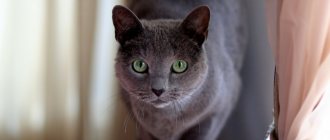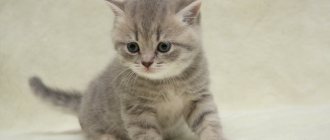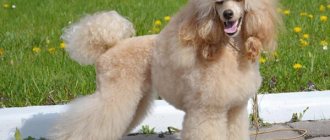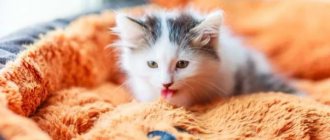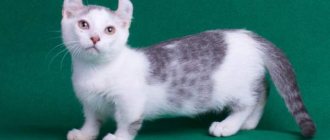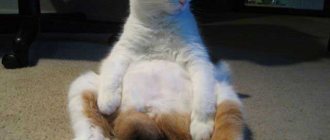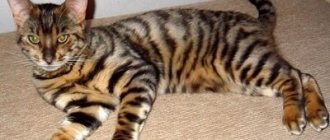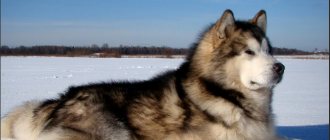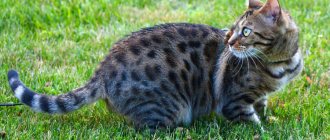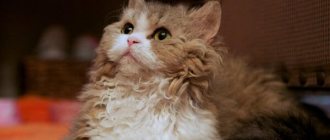A mustachioed pet with an affectionate character and cute appearance is always the one and only for all owners. But if we talk about rare breeds, then this expression takes on a literal meaning.
Representatives of the cat family that belong to them have an unusual appearance, an individual character, sometimes too difficult, but at the same time they are endowed with an excellent mind and developed intelligence. Their main advantage is their bright appearance, they have a unique color, soft fluffy or smooth coat.
If you are planning to get a cat or a cat of a rare breed in the future, then it is worth considering their types and characteristics.
10.Serengeti
The Serengeti is a graceful, stately medium-sized cat with a strong muscular body, long legs, strikingly large round ears equal to the height of its head, and bright yellow eyes. Thick, short fur with a silky texture can be light brown, silver, or spotted in color. Animals weigh from 3.5 to 7 kg. By nature, the Serengeti is confident, open, and friendly. They are energetic and active and love to climb to heights. The breed was developed in 1994 in California by crossing Bengal and Oriental shorthair cats to create a serval-like species, and is named after its habitat, the Serengeti Park. Nowadays they are bred in the USA, Europe, and Australia, but representatives of the genus are few in number.
9.Caracal
The caracal is also known as the Persian or steppe lynx, although the lynx belongs to a separate genus of the cat family. The caracal is believed to be closely related to the African golden cat and the serval, hence its strength and speed. The name caracal comes from the Turkic karakulak, meaning “black ear”. The outer side of his ears is painted black, and long black tassels (4-5 cm) protrude from the edges. The fur on the body is very soft and can be reddish brown, sandy, gray or black. The length of the animal is 65-90 m, and the weight is from 8 to 18 kg. The cacaral is a wild cat that lives in savannas, tropical grasslands, wooded, mountainous areas in the Middle East, Africa and Southwest Asia. Their populations are rapidly declining due to poaching and habitat destruction. No more than 100 caracals live in the Russian forests of Dagestan; the Turkmen subspecies, of which no more than 300 individuals remain, is endangered. To preserve caracals, they are kept in reserves or at home. Tame caracals are affectionate, playful, and extremely valuable.
Turkish van
The history of the appearance of this breed originates from the shores of the salt lake Van in the Armenian Highlands in eastern Turkey. It was in these relatively harsh and inhospitable mountainous regions that long-haired creatures of dazzling white color first appeared.
After a memorable report about Turkey made in 1955 by an English journalist, people in Europe learned about such interesting cats, becoming interested in the unexpected discovery. A few years later, a new breed of cat was registered, which was called the Turkish Van.
In appearance, the Turkish Van is very cute and friendly, which in no way correlates with the area that is considered his homeland. Long white fur, occasionally speckled with reddish spots, sparkles in the sunlight like sparkling snow cover on mountain peaks.
And the dimensions of these imposing felines can surprise: males weigh up to 10 kg, and at the withers their height will be about 30 cm. Females are a little more modest. Their weight varies between 5–7 kg, but their color and pleasantness to the touch remains the same in both cats and females.
Like the Turkish Van, Persian, Siberian, Somali, Himalayan, Burmese, Neva Masquerade, Balinese cats, Kuril Bobtails, Nibelungs, Maine Coons, Turkish Angoras, Ragdolls, Selkirk Rexes have a fluffy coat.
A common feature of the Turkish Van breed is the multi-colored eyes. So, these cats can combine a wide variety of iris color variations - from pale blue and dark blue to bright yellow and red-golden.
The character of the Turkish Van is flexible, soft and open to communication with people, but it is almost impossible to pick up such a pet, because the Van is very freedom-loving and does not tolerate unnecessary encroachments on his independence. He can decide for himself when to come to the owner and lie down on his lap or, more interestingly, on his neck.
Then you are allowed to stroke and cuddle your pet, and if you scratch the cat’s tummy, the van will turn on its back and spread out in all its splendor, scattering its paws and tail in different directions.
Did you know? In summer, the Turkish Van loses up to 80% of its volume due to the fact that the natural process of molting removes the fur that has grown up during the cold season from the animal. So in the hot season, you may not recognize this breed among ordinary yard cats: they become very thin without a voluminous snow-white fur coat.
You should not expect long periods of calm and drowsiness from Turkish Van cats. By nature, they are very active and restless, which is to blame for the mountainous terrain of their homeland, where they had to travel several kilometers over rough terrain in search of food. These cats are afraid of dark and remote corners, and small rooms will be too crowded for them.
It is quite difficult for Turkish Vans to get along with other animals, given their increased predisposition to hunting and the development of hunting instincts. But if you can’t compete much with animals larger than a cat, then with small pets, like hamsters or birds, it’s better to be careful, because Van will not fail to take the opportunity to use his skills as a born hunter.
Important! To make your pet as comfortable as possible indoors, provide him with maximum access to window sills, a balcony or, if you have one, an open terrace so that the animal can feel like part of the big world.
The Turkish Van loves walks very much, and therefore this breed is perfect for owners of a country house. But it’s better not to let Vans near children, especially when they are still kittens. At this age, the Turkish Van does not yet know that he is a pet, and the blood of his wild relatives boils in him, and therefore such cats will scratch and bite, and in addition, small children often cross the line of what is permitted, which causes a lot of indignation among cats.
Toyger
Toyger is a cat with the appearance of a tiger, but a calm disposition. The breed was developed in the early 1990s. American Judy Sugden, who strives to create a cat in the form of a miniature tiger. She crossed a Bengal domestic shorthair cat and an outdoor cat with unusual stripes on her head, brought from Kashmir (India). The result was a cat with a long body and clear vertical stripes, creating a circular pattern across the body. Like tigers, the toyger has an orange upper body and white inner body. The stripe pattern is unique to each individual. A muscular body, powerful hind limbs, and high shoulders give the toyger the agile gait of a tiger. Animals weigh from 3 to 7 kg. Toygers are very smart and easy to train. Pets have a friendly, balanced character and love to be in company.
7.Laperm
Laperm is a unique cat, charming with its soft, curly “fur coat.” Perm means “perm” in English. Laperm has a muscular body, expressive almond-shaped eyes, large cupped ears, and coat of all possible colors. Adults weigh from 3 kg to 5 kg. The species appeared in 1982 as a result of a natural mutation of the rex. On a farm in Oregon (USA), a mouse cat gave birth to 6 kittens, one of them was completely hairless with a striped pattern on the skin. After 6 weeks, the kitten developed short, wavy fur with a brown spotted pattern and was named “Curly.” By four months, the fur has grown, gaining fullness and length. This gene was carried by males and females into subsequent generations. Now Laperm is bred mainly in America. They are active, smart, and will carefully think through how to get what they want. Their affectionate, loving nature allows them to get along well with people and animals.
6.Chausie
The name of the breed comes from the Latin name of the jungle cat felis chaus, which lives in Africa and South Asia in swampy areas near rivers and lakes. Chausie is a tall, long-legged, lithe cat with an athletic build suitable for running and jumping. She has high-set, straight ears, sometimes with tufts at the tips, slightly drooping eyelids, yellow or green eyes, and gentle brown fur. The weight of adults is from 7 to 11 kg. The Chausie breed was created by crossing a jungle cat and a domestic cat. Jungle cats, or swamp lynxes, were domesticated and highly revered by the ancient Egyptians for their easy temperament and hunting skills. There have been many cases of marsh lynx mating with domestic species, but the first breeding was registered in 1990. Chausies are very smart, good-natured, and affectionate. They are active, playful, form close bonds with family members and do not like to be alone. They are bred in Europe and North America; purebred individuals are rare.
Rare and expensive
Next we will tell you about the rarest and most expensive types of cats:
- Khao Mani is a Thai breed, the distinctive feature of which is its snow-white coat and congenital heterochomy (different colors of the iris of the eyes). A kao-mani kitten can reach a price of $2000. Otherwise, a cat of this breed is an affectionate friend and reliable companion.
The breed is also called "diamond eye"
- Peterbald is a breed named after the founder of St. Petersburg, Peter I. Otherwise, they are called “Petersburg Sphynxes”; the price for a kitten can reach $3,000. This is a graceful and very sophisticated breed with high loyalty to people and other animals. They love the sun very much and are extremely talkative.
Peterbald translates as “bald Peter”
- Safari is a breed with a wild and exotic appearance. The price can reach $7000. Safari cats are friendly and intelligent, they love to play and spend time on walks. They love water, so any puddle in their field of vision will be explored to their fullest.
Safari is practically a domestic leopard
- Savannah is considered the most expensive breed in the world; the price per individual can reach $20,000. The demand for the breed is not falling; many are attracted by the wild and noble appearance of these cats. Cats of this breed are affectionate, graceful, and love to play and swim.
Shroud has inherited the grace and wildness of her ancient ancestors
- Chausie is the result of a mixture of the Abyssinian cat and the swamp lynx. The weight of an individual can reach 15 kg, but despite this the animal always looks slender and very graceful. The price per individual can reach $10,000. These are smart and active animals, but the owner should monitor their diet - cats of this breed love to eat a lot.
Chausie can sometimes be confused with the Abyssinian breed, from which they took the best - beauty and intelligence
5.Havana
The Havana is a striking cat with a luxurious dark brown or lilac coat, highlighted by light green oval eyes. Distinctive features are large rounded ears, slightly tilted forward, and a wedge-shaped head. Animals weigh from 2.5 to 4.5 kg. The breed was developed in the 1950s. in England with the help of the Siamese and the Black Shorthair and was recognized by the Cat Fanciers' Association in 1958 as the Chestnut Shorthair, but the name was changed to Havana in 1970. In the 1950s. Havanas were imported to the United States to create the new Havana Brown breed. Havana is inquisitive, mischievous, smart, and easily adapts to different situations. He is playful and sociable, needs attention and returns it with great love. Until the 1990s. There were only 130 individuals of Havana in the world, then the number increased slightly.
Caracal
The cat is similar in appearance to a lynx, its ears are also decorated with black tassels. It lives in the deserts and steppes of the Arabian Peninsula, Asia and India.
Although the breed is wild, the caracal is easily tamed - in ancient times these cats were used to hunt small animals.
The weight of caracals can be up to 15 kg, and their height is 50 cm at the withers. They need a spacious enclosure, as caracals are very playful and can easily turn the whole house upside down.
You can learn about other large cat breeds from the article:
Burmilla
The Burmilla is a medium-sized cat with a muscular, elegant body. Its distinctive feature is its thick silvery coat with a silky sheen, against which its intelligent green eyes stand out. There are short-haired and semi-long-haired individuals. The history of the breed begins in 1981, when in Great Britain, as a result of an accidental mating of a lilac Burmese cat with a Persian chinchilla cat, four short-haired silver kittens were born. The name "Burmilla" comes from the parent species. Representatives of the species have a calm, balanced, inquisitive character. The mischievous nature of the Burmese, mixed with the lightness and ease of the Persian chinchilla, makes it sociable, playful and gentle.
Elf
The Elf cat is a new and extremely rare hybrid species that arose as a result of crossing the Sphynx with the American Curl. She inherited the lack of fur, wrinkled skin, athletic muscular body, long tapering tail from the Sphynx and curled back ears from the American Curl. Elf cats come in all colors and patterns. Although the breed is considered hairless, short, fine hair may grow on the legs, ears, nose, and tail. Elves weigh from 4 to 7 kg. They are smart, friendly, sociable, affectionate. They are also very playful, mischievous, and adapt to any situation in the house. The breed was bred by breeders from the USA in 2006, but has not yet been registered with the International Cat Association. At exhibitions she is shown as a sphinx with special features. There are no more than 50 elves in the entire world.
9) Manx
The homeland of the Manx cat or Manx cat is the Isle of Man, hence the name. This breed is known for having no tail, although some do have a short tail. This characteristic feature is a natural feature of the Manx, which appeared several centuries ago. The cat has been known in its homeland since the 18th century.
2.Savannah
Savannah is a unique and amazing species of the cat family, numbering no more than 1000 individuals worldwide. This tall, slender animal with striking black or dark brown spots is very similar to its iconic source, the African serval, but smaller in stature. It has an elegant physique - a thin neck, long paws, rounded straight ears, and weighs from 3.2 to 9 kg. The first known Savannah was born on April 7, 1986, when a domestic cat gave birth to a Serval kitten. The kitten, named "Savannah", inherited traits from both parent species. The peculiarity of the savannah is its individuality. This is a very original, curious, assertive cat looking for adventure. The animal is attentive and strongly attached to family members. Many of them love to jump on high furniture and play in the water.
1.American Wirehair cat
The rarest breed of domestic cat in the world is the American Wirehair. It is a medium-sized, muscular, robust animal with clear eyes, wide-set, round ears, fur of various colors and patterns, and a quiet voice. The breed arose as a result of a natural mutation of the American Shorthair cat. The first representative was born in 1966 in the litter of a farm cat in northern New York. The kitten has grown brown-white, hard, dense, elastic fur, different from the parent species. The fur was considered unique because the hairs in all layers were twisted, like thin wires, with curved ends. The character of the American Wirehair cat is identical to the American Shorthair: they are good-natured, observant, calm, but can remain playful throughout their lives. The gene that gives the coat a hard texture is not dominant in the offspring of the American Wirehair, so such kittens are born very rarely. In the early 2000s. There are only 22 cats registered in the world, and the number has not increased significantly since then.
Related Posts
Top 10 rarest dog breeds
Top 10 Most Beautiful Cat Breeds in the World The Largest Wild Cats
Reasons for the rarity of the breed
Speaking about rare breeds of cats, it is worth thinking about why they are classified in this category and, accordingly, have considerable value. Everything here determines the population size, and the exclusivity of representatives can be determined by several factors:
- recently bred breeds are representatives of felines that are not yet widely known and popular. They are not common, since their breeding is usually a difficult process, which leads to the high cost of kittens, or simply not enough time has passed to popularize the new breed;
- ancient breeds, the breeding of which is difficult. They have a long history and great fame, but their population numbers are low, putting them at risk of extinction.

